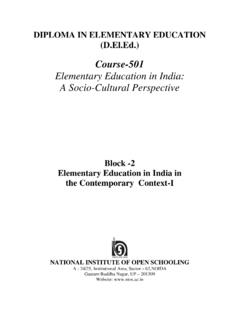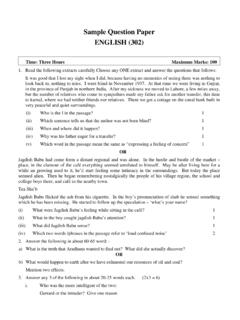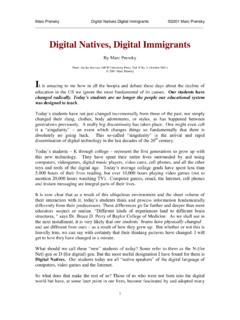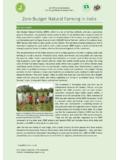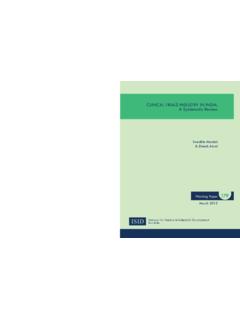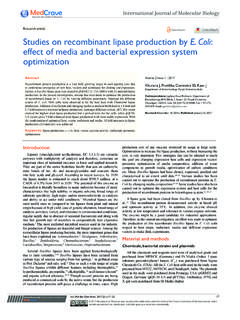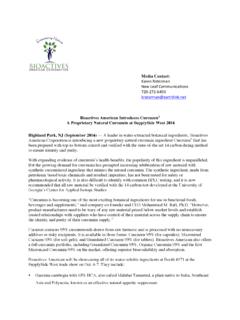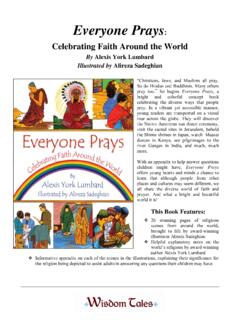Transcription of 18 LOCAL GOVERNMENTS AND FIELD ADMINISTRATION
1 SOCIAL SCIENCEMODULE - 3 LOCAL GOVERNMENTS and FIELD AdministrationDemocracy at Work 60 Notes18 LOCAL GOVERNMENTS ANDFIELD ADMINISTRATIONR amphal had left his village and come to a city in search of livelihood. His familyalso joined him there when he got a job. After a gap of 8 years, he and his son,Vijay visited his native village. Both were surprised to see a newly built primary schoolwith a boundary wall, a volley ball ground and the village tube well with a park aroundit. All these had come up after they had left the village. Vijay also saw his youngercousins playing with the children of the high caste people the privileged class. It wasa pleasant surprise for him, because earlier, they being poor and considereduntouchables were not allowed to play with the children of the privileged was curious to know how all that could happen.
2 When he chanced to meet theschool teacher, Vijay asked him the reasons behind the changes. The teacher saidthat those changes were the outcome of the efforts made primarily by the newlyelected Sarpanch and Panches of the Gram Panchayat with the support from thefield ADMINISTRATION . Vijay felt still happier when came to know that one of his auntieshad also been elected as a Panch. He wanted to know more about LOCAL governmentinstitutions like Gram Panchayat and FIELD ADMINISTRATION . In this lesson, the detailsas told by the teacher have been completing this lesson you will be able to: recognize the need to establish LOCAL government in villages and cities; appreciate the efforts of people to strengthen the democracy through localgovernments; analyse the structure and functions of the LOCAL government in India (rural as wellas urban; analyse the changes made by 73rd and 74th amendment of Constitution andappreciate the steps taken towards women s empowerment.)
3 MODULE - 3 Democracy at Work 61 LOCAL GOVERNMENTS and FIELD AdministrationSOCIAL SCIENCEN otes recognize the necessity and importance of different officers at different levelsof FIELD ADMINISTRATION for assisting the representatives for better functioning oflocal GOVERNMENTS ; and appreciate the role of LOCAL GOVERNMENTS in our daily LOCAL GOVERNMENTV ijay asked the teacher why a Gram Panchayat is called a LOCAL governmentinstitution. You must be aware by now that India being a federal system hasgovernments at two levels, Union government at the Centre and State governmentsat the state level. Besides these two GOVERNMENTS , the Constitution of India hasprovided for a set of institutions for rural and urban areas, commonly known as Localgovernment.
4 It is the third tier of the government aimed at development and socialjustice at the LOCAL level and acts as an instrument of decentralization of powers. Thisis said to be the best government largely because of its closet interface with the localpeople. It provides a forum to them to deliberate on the nature of LOCAL problemsand devise appropriate solutions that are in conformity with the LOCAL situations. Localgovernment is in fact a government of the LOCAL people, by the LOCAL people and forthe LOCAL people. Being located nearest to the people, the LOCAL government institutionsare under constant observation of the society. This goes a long way in enhancinglocal government s accountability. In fact, the role of LOCAL self- government institutionsis so pervasive and the services provided by them is so closest to the daily lives ofthe LOCAL communities that it is said to serve the LOCAL citizenry from cradle to thegrave.
5 The teacher asked Vijay if he knew that right from ancient times there had been somesort of community based institutions in different parts of India. They had beenvariously known as Panchayats, Biradaries or by some other names. The eldestperson or any other commonly accepted leader used to deal with different problemsof the members of the village or community. In many films or serials you musthave noticed Panchayats listening to the complaints of the members and makingdecisions to resolve the issues. A story Panch Parmeshwar by renowned litterateurPrem Chand also depicts the role of Panchayat. That old traditional organization Panchayat is still prevalent and working in the villages. Keeping in view theimportance, acceptance and utility of this traditional institution, the government ofIndia has continued with this system to work for the welfare of the Rural and Urban LOCAL GovernmentHe further shared that it is not only in the villages where LOCAL GOVERNMENTS areworking.
6 In cities also there are LOCAL bodies which are working for the welfare ofthe city dwellers. The only difference is that rural LOCAL bodies have a smaller areaSOCIAL SCIENCEMODULE - 3 LOCAL GOVERNMENTS and FIELD AdministrationDemocracy at Work 62 Notesand smaller population to look after but the LOCAL bodies of the cities have larger areaand population to look after. The LOCAL GOVERNMENTS in India thus are of two types,one for the rural areas and the other for the urban areas. The system of rural localgovernment is known as the Panchayati Raj System and that of the urban localgovernment has three kinds of institutional arrangements in different cities and are known as Municipal Corporations, Municipalities and Nagar organization and functioning of both the Panchayati Raj System and Urban localgovernments have been greatly influenced by the 73rd and 74th ConstitutionalAmendment Acts PANCHAYATI RAJ SYSTEMAs we have seen earlier that in the past, Panchayats used to be the seat of disputes and other problems were referred to Panchayats and their decisionsused to be respected by one and all.
7 Our national leaders like Mahatma Gandhi hada firm faith in this system. The Constitution makers also considered this system tobe very important and made provisions for it in the Directive Principles of State Constitution states that the State shall take steps to organize Village Panchayatsand empower them with such powers and authorities as may be necessary to enablethem to function as units of LOCAL self a follow up, the present day Panchayats began functioning under the CommunityDevelopment Programme introduced during the first Five year Plan. To make thesystem more effective a Committee was formed under the Chairmanship of BalwantRai Mehta that went into its details. The Balwant Rai Mehta Committee in its reportMODULE - 3 Democracy at Work 63 LOCAL GOVERNMENTS and FIELD AdministrationSOCIAL SCIENCEN otessubmitted in 1957 recommended the establishment of a three-tier Panchayati RajSystem: Gram Panchayats at the village level, the Panchayat Samitis at the block levelor intermediate level and the Zila Parishad at the district level.
8 In 1958, the NationalDevelopment Council also recommended a similar structure of LOCAL governmentwhere village was at the bottom of the system and district at the top. However, itis the 73rd Constitutional Amendment 1992 that provided the present shape to thePanchayati Raj System. Now the Panchayati Raj Institutions in most of the Stateshave been set up at three levels, village, intermediate and district levels. But in smallerStates having a population of less than 20 lakh, there are only two tiers, the villagelevel and the district The three tier structure of Panchayati Raj The 73rd Constitutional Amendment 1992 The passage of the Constitution (73rd Amendment) Act, 1992 marks a new era inthe federal democratic set up of the country and provides constitutional status to thePanchayati Raj Institutions (PRIs).
9 The main features of the Act are:(i)establishment of a three-tier structure: Village Panchayat (Gram Panchayat);intermediate panchayat (Panchayat Samiti; and the district panchayat (ZilaParishad);(ii) regular elections, every five years;(iii) reservation of seats for the Scheduled Castes and Scheduled Tribes inproportion to their population;(iv) not less than one-third reservation of seats for women at three different levelsof PRIs;(v) establishment of State Finance Commissions to recommend measures toimprove the finances of panchayats;ZILA PARISHAD(DISTRICT LEVEL)PANCHAYAT SAMITIES(BLOCK LEVEL)GRAM PANCHAYATS(VILLAGE LEVEL)SOCIAL SCIENCEMODULE - 3 LOCAL GOVERNMENTS and FIELD AdministrationDemocracy at Work 64 Notes(vi) establishment of State Election Commissions to conduct election to the PRIs;(vii)establishment of District Planning Committees to prepare development plans forthe districts;(viii) preparation of plans for economic development and social justice and theirexecution concerning 29 subjects listed in the 11th Schedule of the Constitution;(ix)establishment of Grama Sabha (village assemblies) and their empowerment asa decision making body at the village level.)
10 And(x) rotation in accordance with the reservation of seats for women and theScheduled Castes in the the Constitution (73rd Amendment) Act, the Panchayati Raj Institutions have beengiven such powers and authority as may be necessary to enable them to contains provisions for devolution of powers and responsibilities related to (a) thepreparation of plans for economic development and social justice; and (b) theimplementation of such schemes for economic development and social justice as maybe entrusted to upon the enactment of the 73rd Constitutional Amendment Act,almost all the States/UTs, except J&K, NCT Delhi and Uttaranchal haveenacted their legislation. Moreover, almost all the States/UTs have held localbody elections.


